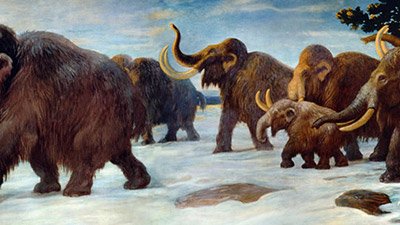
“Mr. Ice Age” Solves Woolly Mammoth Mystery
The woolly mammoths have puzzled scientists for hundreds of years, but Ice Age researcher, Mike Oard, has proposed a radical solution in the latest issue, 14(3), of TJ.
According to Oard, there is nothing particularly unusual about the mammoths themselves. “They are essentially a hairy elephant,” Mike explains. “The woolly mammoth has two distinctive spirally curved tusks up to 3.5 metres long. It has a large shoulder hump, small ears, a tiny tail and a small trunk. Its coiled locks of dark hair cover a silky under-fur.”
“But”, says Oard, “there are many perplexing questions relating to the Siberian mammoth finds. Why would they want to live in Siberia anyway?” The point is that they need a grassland environment with a long growing season, mild winters and very little permafrost—quite different from the climate in the region today.
“There is another bewildering feature,” Mike Oard explained. “They are not found in isolation, but with a wide variety of other mammals, large and small, many of which were grazers. Indeed, there have been many hundreds of thousands of large mammoths found in Siberia, and many millions of bones.”
What did they eat? Siberia today supports only a few large animals, and, unlike the woolly mammoth, these are well suited to the boggy conditions and the sparse vegetation.
Perhaps they migrated for the winter. But that raises more questions than it answers, and already there are enough questions to deal with.
Most perplexing of all, how did they die and how were the carcasses frozen?
Most perplexing of all, how did they die and how were the carcasses frozen? “To freeze like that, and for the tusks and bones to be well preserved, quick burial is necessary,” Mike said. “There needs to be a plausible explanation for how all those mammoths ended up in the rock-hard permafrost.”
What about the amazing preservation of their stomach contents? Was an asteroid involved? Where does Noah’s Flood fit in?
Many theories have been advanced but according to Mike, the solution is staring us in the face. It is in the loess blankets found in those regions today, those fine silt deposits that were blown into place by the wind. It forms “yedomas” in Siberia and “muck” in Alaska.
The full article about the woolly mammoth extinction is found in the latest issue, 14(3) of TJ (see online version, PDF file).

Answers in Genesis is an apologetics ministry, dedicated to helping Christians defend their faith and proclaim the good news of Jesus Christ.
- Customer Service 800.778.3390
- Available Monday–Friday | 9 AM–5 PM ET
- © 2025 Answers in Genesis


